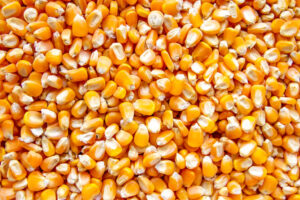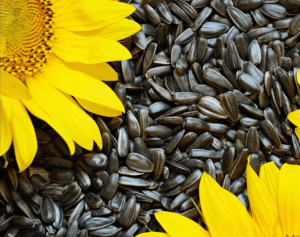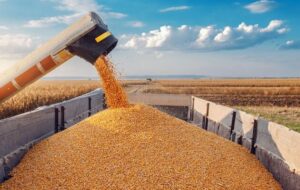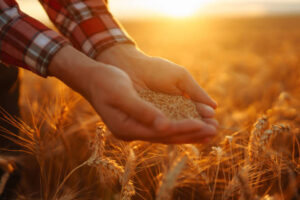
The corn market is currently the most active segment of Ukrainian grain exports, ensuring stable port loading and constant demand from importers, according to the analytical cooperative “Pusk,” created within the framework of the All-Ukrainian Agrarian Council (VAR).
“Corn currently remains the only relatively active market segment. As of December 22, exports amounted to almost 1.5 million tons. Although these volumes are not record-breaking, shipments are stable, and it is corn that keeps most ports operating today,” analysts said.
According to their information, demand for corn on the world market remains high. Ukrainian corn remains in demand in EU countries, particularly in Spain and Italy, which are among the key buyers, as well as in Turkey.
At the same time, importers are closely monitoring the security situation in Ukraine.
“Importers are aware that the war is not expected to end quickly in the coming months and that risks to port infrastructure will remain. If exports from Ukraine are halted or significantly reduced, it will be difficult for the global market to quickly cover the possible deficit. American corn has already been contracted for January and almost entirely for February, so there are virtually no alternatives to Ukraine for supplies during this period,” experts said.
At the end of the week, spot corn prices rose to $207–208 per ton, while domestic contract prices rose to 9,800–9,850 UAH/ton.
“Further price dynamics will largely depend on the growth rate of logistics costs and security risks,” Pusk said.

As of December 5, farmers have harvested 53.597 million tons of grain and legumes from 10.55 million hectares, which is 91% of the area sown with these crops, according to the Ministry of Economy, Environment, and Agriculture.
According to the Ministry of Economy, 23.5 million tons of corn have been harvested from 3.44 million hectares. As for wheat, its yield is slightly higher than a year ago – 22.96 million tons from 5.05 million hectares compared to 22.40 million tons from 4.9 million hectares, while barley is slightly lower – 5.42 million tons from 1.36 million hectares compared to last year’s 5.6 million tons from 1.41 million hectares.
This year’s pea harvest is significantly higher – 672,500 tons from 275,100 hectares compared to 469,000 tons from 212,300 hectares a year ago, while buckwheat and millet are still significantly lower – 82.7 thousand tons compared to 131.7 thousand tons and 62.1 thousand tons compared to 161.3 thousand tons, respectively.
The harvest of other cereals and legumes this year reached 899.6 thousand tons from 327.8 thousand hectares as of December 5, compared to 1 million tons a year ago.
The Ministry of Economy has calculated that the corn harvest has been gathered from 78% of the production areas allocated for this crop, millet – from 88%, buckwheat – from 97%, wheat and barley – from 98%.
As for oilseeds, their harvest as of December 5 is 17.11 million tons. In general, sunflower has been harvested from 93% of the sown areas, and soybeans from 97%. The rapeseed harvest has been completed, and it turned out to be only slightly less than last year’s – 3.31 million tons against 3.5 million tons from almost identical areas – about 1.3 million hectares.
Currently, 4.75 million tons of soybeans have been harvested from 2.00 million hectares, while 9.04 million tons of sunflower seeds have been harvested from 4.81 million hectares.
In addition, the harvest of sugar beets is also lagging behind: 98% of the production area has been harvested, yielding 10.39 million tons from 195,000 hectares.
In its October inflation report, the National Bank of Ukraine increased its estimate of the grain and legume harvest in 2025 to 61.5 million tons from 57.9 million tons in the July report, while lowering its estimate of the oilseed harvest to 19.3 million tons from 21.0 million tons.
The NBU recalled that last year, the grain harvest in Ukraine fell to 56.2 million tons from 59.8 million tons in 2023, and oilseeds from 21.7 million tons to 20 million tons.

The Food and Agriculture Organization of the United Nations (FAO) has completed the distribution of 615 modular grain storage facilities to small and medium-sized farms in seven frontline areas, the FAO press service reported on Facebook.
The FAO specified that this initiative was implemented with the support of the governments of Canada and Japan in close cooperation with the Ministry of Economy, Environment, and Agriculture. The FAO is convinced that the program contributes to stabilizing the work of farms, preventing post-harvest losses, and ensuring the continuity of agricultural production.
Farmers could apply to participate in the program through the State Agrarian Register (DAR). In 2025, the FAO received 747 applications from producers who cultivate between 200 and 1,000 hectares. After verification, 615 farms were selected to receive modular grain storage facilities. The distribution took place in seven regions: Chernihiv (62), Dnipropetrovsk (116), Kharkiv (124), Kherson (14), Kirovohrad (84), Mykolaiv (128), and Odesa (87).
This initiative is part of a broader Grain Storage Support Strategy that FAO and partners have been implementing since 2022 in response to a critical shortage of storage capacity. During this time, Ukrainian agricultural producers have received a wide range of storage solutions – more than 37,000 grain sleeves, 105 sets of loading and unloading equipment, and a total of 859 modular grain storage facilities. Collectively, this support has enabled farmers across Ukraine to preserve more than 8 million tons of grain and sustain agricultural production in wartime conditions.
Despite significant progress, the lack of storage infrastructure remains a key constraint to the recovery of the agricultural sector, especially in frontline and recently liberated areas, the FAO stressed. As preparations for the 2026 season get underway, the sustainable development of modern and secure grain storage facilities will remain critical to protecting livelihoods and preserving national food production.
“For farmers, the ability to safely store their harvest is not just about grain. It’s about peace of mind, about the confidence that months of hard work will not be lost. These storage facilities give Ukrainian farmers what is especially needed today in times of war: stability and the ability to look to the future with hope. We will continue to support them on this path,” assured Shakhnoza Muminova, Head of the FAO Office in Ukraine.
FAO, together with its partners, plans to provide support to approximately 100 more farmers in early 2026, but the scale of needs far exceeds available resources. Strengthened cooperation and continued active involvement of the international community will be key to enabling farmers to withstand ongoing challenges and contribute to Ukraine’s long-term recovery, the organization believes.

The Ukrainian Grain Association (UGA) forecasts that the harvest of grain and oilseeds in 2025 will reach 81.4 million tons, compared to 79 million tons (+3%) a year earlier, the association’s press service reported.
“With such a harvest, exports in the current 2025/26 season could potentially reach 49 million tons (last season – 46.7 million tons). However, this is an optimistic scenario, the implementation of which depends on the resolution of serious logistical problems,” the UGA noted.
The association recalled that Ukraine is currently experiencing significant problems in grain export logistics due to constant Russian terrorist attacks on critical infrastructure: energy, railways, and seaports of Ukraine. As a result of Russian shelling of civilian infrastructure, railways and ports cannot operate at full capacity due to damage to their infrastructure, power shortages, and constant power outages.
“It is obvious that the inability to export significant volumes of the harvested crop due to logistical problems will not only have an extremely negative impact on Ukrainian agricultural producers and the price situation on the domestic market, but may also deal a severe blow to Ukraine’s economy and its balance of payments,” the UGA noted.
The UGA estimated the wheat harvest in 2025 at 22.5 million tons, compared to 22.4 million tons (+0.45%) a year ago. With this in mind, potential wheat exports in 2025/26 MY could reach 16.5 million tons, the UGA suggested.
The barley harvest in 2025, according to the association’s estimates, is 4.9 million tons, compared to 5.6 million tons (-2.5%) a year ago, and the likely export in 2025/2026 MY is forecast at around 2.3 million tons.
The UGA expects the corn harvest to reach 32 million tons, compared to 25.9 million tons (+23.6%), and experts believe that potential exports in the current season could reach 25 million tons, provided that logistics are unhindered.
The UGA forecasts the sunflower harvest in 2025 at 11.5 million tons, compared to 12.8 million tons (-10.2%) a year ago. Traditionally, almost all sunflowers will be processed in Ukraine – 11.4 million tons, while exports will reach no more than 50 thousand tons.
The rapeseed harvest in 2025 will be 3.2 million tons, compared to 3.8 million tons (-15.8%) a year ago, while exports in 2025/26 MY may reach only 2.1 million tons, with the rest being processed in Ukraine.
According to the UGA, the soybean harvest in 2025 will be about 5 million tons, compared to 6.8 million tons (-26.5%) in 2024, which is explained by a significant reduction in the area sown with this crop and poorer yields. Nevertheless, potential exports could reach 2.5 million tons in 2025/26 MY, with the rest being processed in Ukraine, as legislative restrictions make its export difficult, as is the case with rapeseed.
“As for next year’s harvest, since the acreage under winter crops is already known and taking into account the forecast for spring crops, next year’s potential harvest could amount to 84.5 million tons of grains and oilseeds, of which Ukraine could potentially export about 50 million tons of grains and oilseeds,” the UGA predicts.
The Ukrainian Grain Association (UGA) is an association of producers, processors, and major grain exporters, which annually export about 90% of Ukrainian grain products.

Kernel, one of Ukraine’s largest agricultural holdings, exported 1.3 million tons of grain in July-September 2026 (FY, July 2025-June 2026) exported 1.3 million tons of grain, which is 15% less than in the same period last year, but 27% more than in the previous quarter, thanks to greater availability of grain on the domestic market after the start of the winter wheat harvest.
According to the published quarterly report, wheat accounted for 74% of Kernel’s total exports, with the rest being corn and barley.
“The start of the new financial year for the Infrastructure and Trade segment was shaped by two key market dynamics: a delay in the harvesting campaign in Ukraine caused by weather conditions and slower-than-usual sales by farmers,” the agricultural holding said.
As a result, the cargo turnover of export terminals in the first quarter of FY 2026 amounted to 1.8 million tons, which is 17% less than in the same period last year, leading to a decrease in grain exports and the group’s overall sales portfolio of vegetable oils and meal.
Grain accounted for 75% of the total cargo turnover, edible oils for 13%, and vegetable meal for the rest.
The volume of grain received by silos in July-September 2026 FR amounted to 1.2 million tons, which is 34% less than in the previous year. Of this amount, 796 thousand tons were received from the agricultural holding’s own agricultural enterprises, and the rest from third-party suppliers.
“The decrease in arrivals mainly reflects the later start of the group’s harvesting campaign, as unfavorable weather conditions and uneven ripeness of crops in different regions delayed and reduced deliveries to warehouses,” Kernel explained.
The Infrastructure and Trade segment generated EBITDA of $20 million in the first quarter of 2026 FY, down 62% from the previous year.
Before the war, Kernel was the world’s leading producer of sunflower oil (about 7% of global production) and its exporter (about 12%). It is one of the largest producers and sellers of bottled oil in Ukraine. In addition, it is engaged in the cultivation and sale of agricultural products.

The Food from Ukraine platform symbolizes the expansion of Ukraine’s initiative from a focus on grain alone to finished products, as well as the transfer of technological knowledge, said Minister of Economy, Environment, and Agriculture Oleksiy Sobolev at the opening of the IV International Food Security Summit “Food from Ukraine” in Kyiv on Wednesday.
Sobolev noted that Ukraine had already exported 5.8 million tons of wheat in the 2025-2026 marketing year.
“This is not just a figure, it is an indicator of the resilience of our agricultural sector, which continues to operate despite the destroyed infrastructure, constant logistical challenges, drone attacks, and daily risks,” the minister emphasized.
He cited USDA forecast data, according to which wheat exports from Ukraine will amount to 15 million tons by the end of the season, or approximately 7% of global trade in this product.
“This confirms that Ukraine continues, despite everything, to be a reliable partner for the global food market. (…) However, the issue of food security remains relevant and will only intensify. Ukrainian farmers provide food to hundreds of millions of people in different regions of the world, from North Africa to Asia. Our country remains a guarantor of global food security, ensuring the stability of supplies of grains, oilseeds, and livestock products,” Sobolev noted.
As the minister noted, Ukraine understands that demand for food will grow most rapidly. In the coming decades, Sub-Saharan Africa, which currently imports more than two-thirds of its food needs, will account for almost 14% of the increase. The average productivity of farms on this continent is only 40% of their potential, grain losses are up to 20%, and the density of mechanization is only 2-4 tractors per 100 square kilometers, which is dozens of times lower than in Europe.
At the same time, he noted the strong response to these challenges from African countries, which are investing in irrigation, mechanization, the creation of agro-industrial zones, the localization of equipment production, infrastructure development, storage, and processing. According to Sobolev, this is not just modernization, but a strategic course towards self-sufficiency.
That is why, according to the Minister of Economy, one of the strategically correct decisions for Ukraine is to transform the Ukrainian President’s Grain from Ukraine initiative into Food from Ukraine.
“The Food from Ukraine platform will form a new approach to global food policy, combining long-term financing of humanitarian programs with the creation of stable and secure logistics routes, the development of processing and production of products with high added value, the attraction of investments, the technological modernization of the agricultural sector, expanding cooperation with countries in Asia, Africa, Latin America, and island states, as well as establishing partnerships between the government, business, and international organizations to create a sustainable, predictable, and innovative global food system,” Sobolev emphasized.
The minister announced that Ukraine will begin creating a network of regional food hubs as part of this initiative. He showed a video presentation of the first project of such a logistics and processing hub, which is planned to be built in Ghana. Its basic infrastructure will be the storage, processing, and distribution of Ukrainian agricultural products, as well as the localization of modern technologies in West Africa.
Sobolev emphasized that Ukraine and Ghana signed a memorandum of cooperation in Kyiv on Wednesday, laying the foundation for long-term partnership and practical development of the initiative and creation of Food for Ukraine.
“Ukraine is ceasing to be a political donor of food. We are becoming part of the architecture of a new model of global food sustainability, a country that not only helps feed the world today, but also creates mechanisms for innovative production tomorrow,” the Minister of Economy concluded.